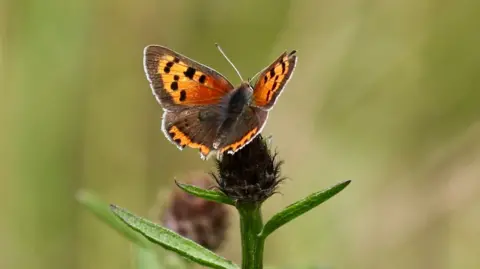The United Kingdom is experiencing an exceptional surge in insect populations this year, attributed to the warmest and sunniest spring on record. The encouraging news revolves around certain species such as ladybirds, butterflies, and wasps, which have been flourishing since the season commenced. According to the Royal Horticultural Society (RHS), the warm start to the summer has seen a dramatic increase in aphid populations, which happen to be the primary food source for ladybirds.
Despite this resurgence, concerns loom regarding the overall insect population for the next year due to the relative lack of rainfall during both spring and summer. The drying wetland areas could lead to reduced egg-laying for many species, resulting in a potentially diminished number of insects and amphibians for the forthcoming seasons. Notably, although this year’s visibility of insect species increased significantly, research indicates that, in the long term, the UK’s flying insect population is on the decline.
Kathryn Brown, the Director of Climate Change and Evidence at The Wildlife Trusts, highlighted that many individuals are witnessing a significant presence of ladybirds and wasps this summer, particularly following a notably poor year for butterflies in 2024. The flourishing of these insect species can be primarily linked to the warm and dry conditions they thrive in. In fact, earlier this year, the RHS predicted an abundant year for aphids, which, while troublesome for gardeners, play a crucial role in the food chain, supporting birds and other insects.
A particularly striking aspect of this year has been the extraordinary number of early butterfly sightings. Dr. Richard Fox, Head of Science at the Butterfly Conservation charity, revealed that 2025 has been remarkable concerning butterfly appearances, with 18 species reported at least two weeks earlier than the average, alongside 24 more observed at least a week early. Frances Hargreaves, a butterfly and wildlife enthusiast, confirmed that this year’s warmth has positively influenced butterflies’ life cycles, allowing them to progress swiftly from caterpillars to adults, thereby increasing their chances of survival.
Lavender fields across the United Kingdom, especially those near Hutchinson’s Bank Nature Reserve in South London, have also benefitted from this weather. These fields not only provide habitats for butterflies and bees but thrive exceptionally well under sunny conditions. Lorna May of Mayfield Lavender in Surrey noted an astounding tenfold increase in honey production this year, attributing it to the lively bee population. However, challenges like an increased prevalence of the rosemary beetle—a tiny pest—have arisen. To combat this without resorting to pesticides, volunteers diligently remove the bugs by hand.
While the current conditions seem favorable, there are looming concerns for the future. Kathryn Brown warned of the chaotic impacts of climate change on wildlife, suggesting that extreme weather patterns lead to more erratic cycles within nature. The Met Office’s recent State of the UK Climate report stressed that weather extremes are becoming the norm, with eight of the ten warmest springs occurring since the year 2000.
In summary, the present insect boom in the UK offers a fleeting glimpse of diversity amidst a backdrop of concerning long-term trends in insect populations. While immediate conditions appear favorable for various species, including an increased presence of butterflies and ladybirds, the implications of changing weather patterns and habitat loss remain critical. The insight shared by experts calls for action from individuals and communities to support wildlife, such as reducing lawn mowing frequency, aiding local rewilding initiatives, and creating habitats like ponds—conserving biodiversity for future generations.












